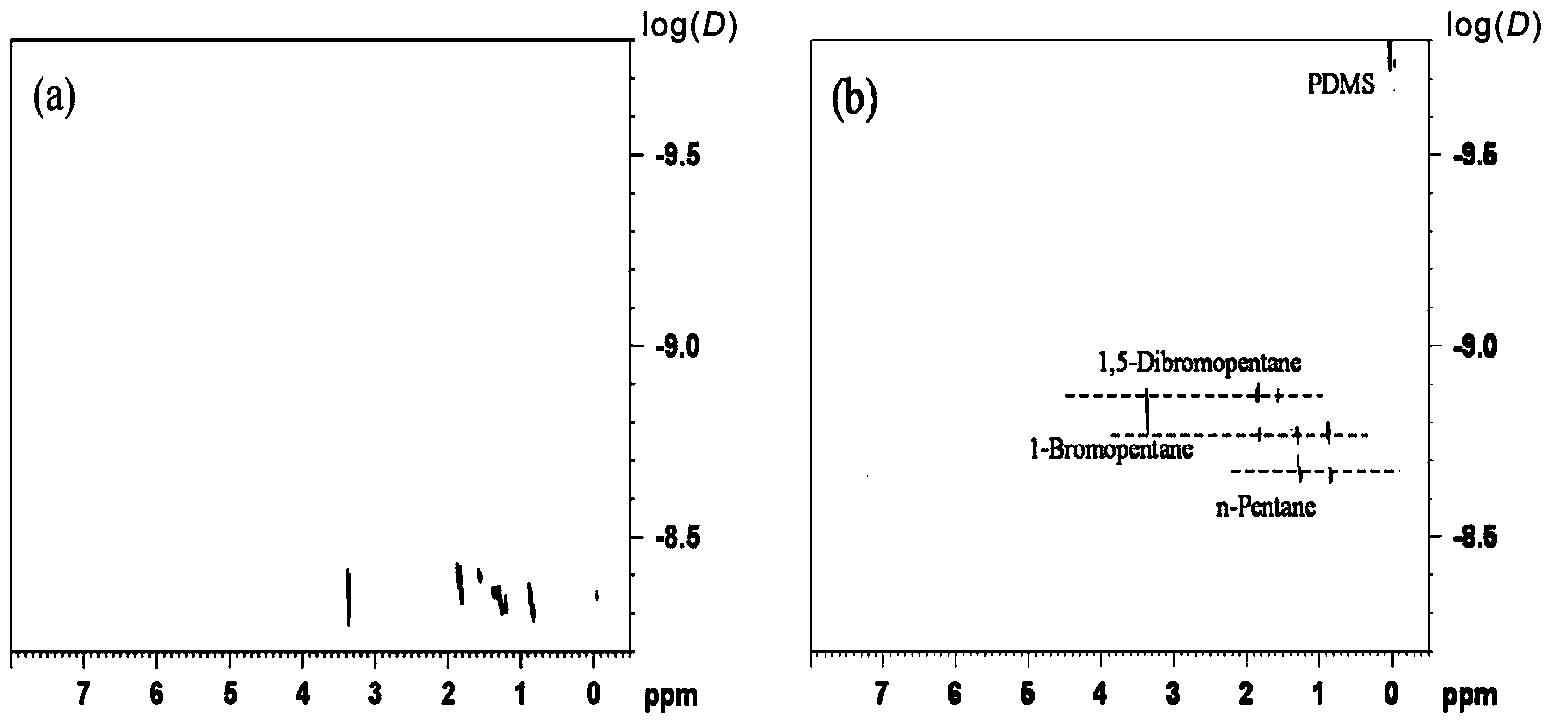Additive for nuclear magnetic resonance spectrum and method for analyzing mixture by virtue of additive
A nuclear magnetic resonance spectrum and analysis method technology, applied in the field of NMR mixture analysis, can solve the problems of small number of compounds, increased solution viscosity, interference component signals, etc., and achieve good practical use value and good scientific research value.
- Summary
- Abstract
- Description
- Claims
- Application Information
AI Technical Summary
Problems solved by technology
Method used
Image
Examples
Embodiment 1
[0025] 1.1 Reagents and instruments
[0026] Polydimethylsiloxane (viscosity: 100mPa.s, neat(25℃)) (PDMS), benzene, naphthalene and anthracene were purchased from China National Pharmaceutical Group Chemical Reagent Co., Ltd., the grade is analytical pure; deuterated chloroform (containing 0.003% TMS, v / v) was purchased from Cambridge Isotope Laboratories, USA, and the grade is NMR pure; nuclear magnet tube (WG-5mm-Economy-7) was purchased from Wilmad, USA; the spectrometer was Bruker AVANCE III 600M NMR spectrum The instrument has a resonance frequency of 600.13 Hz; the probe is a 5mm ultra-low temperature triple resonance trans-detection probe with a gradient of 53G / cm.
[0027] 1.2 NMR experiment
[0028] Add 8 mg of benzene, 8 mg of naphthalene, 8 mg of anthracene, and 0.6 ml of deuterated chloroform to the two nuclear magnetic tubes respectively, and then add 50 mg of PDMS to one of the nuclear magnetic tubes and shake them sufficiently to prepare two NMR samples for use.
[002...
Embodiment 2
[0033] 2.1 Reagents and instruments
[0034] PDMS (viscosity: 200mPa.s, neat(25℃)), 1,5-dibromopentane, 1-bromopentane and n-pentane were all purchased from China National Pharmaceutical Group Chemical Reagent Co., Ltd. The grade is analytical pure; deuterated Chloroform (containing 0.003% TMS, v / v) was purchased from Cambridge Isotope Laboratories, USA, and the grade is NMR pure; NMR tube (WG-5mm-Economy-7) was purchased from Wilmad, USA; Spectrometer was Bruker AVANCE III 600, Switzerland Mega NMR spectrometer, its resonance frequency is 600.13 Hz; the probe is a 5mm ultra-low temperature triple resonance trans-detection probe, and its gradient is 53G / cm.
[0035] 2.2 NMR experiment
[0036] Add 5 mg of 1,5-dibromopentane, 5 mg of 1-bromopentane, 5 mg of n-pentane and 0.6 ml of deuterated chloroform to the two NMR tubes, and then add 80 mg of PDMS to one of the NMR tubes , Fully shake, prepare two NMR samples for use.
[0037] Put the prepared NMR sample tube into the cavity of th...
Embodiment 3
[0041] 3.1 Reagents and instruments
[0042] Hydrogen-terminated polysiloxane (viscosity: 100mPa.s, neat (25℃)), acetic acid, ethanol and acetonitrile were purchased from China National Pharmaceutical Group Chemical Reagent Co., Ltd., the grade is analytically pure; deuterated chloroform (containing 0.003% TMS ,v / v) was purchased from Cambridge Isotope Laboratories, USA, and the grade is NMR pure; nuclear magnet tube (WG-5mm-Economy-7) was purchased from Wilmad, USA; the spectrometer was the Swiss Bruker AVANCE III 600M NMR spectrometer. The resonance frequency is 600.13 Hz; the probe is a 5mm ultra-low temperature triple resonance trans-detection probe with a gradient of 53G / cm.
[0043] 3.2 NMR experiment
[0044] Add 6 mg of acetic acid, 6 mg of ethanol, 6 mg of acetonitrile and 0.6 ml of deuterated chloroform to the two NMR tubes, and then add 60 mg of hydrogen-terminated polysiloxane to one of the NMR tubes, and shake them sufficiently to prepare two One NMR sample for use.
[...
PUM
| Property | Measurement | Unit |
|---|---|---|
| Viscosity | aaaaa | aaaaa |
| Viscosity | aaaaa | aaaaa |
| Viscosity | aaaaa | aaaaa |
Abstract
Description
Claims
Application Information
 Login to View More
Login to View More - R&D
- Intellectual Property
- Life Sciences
- Materials
- Tech Scout
- Unparalleled Data Quality
- Higher Quality Content
- 60% Fewer Hallucinations
Browse by: Latest US Patents, China's latest patents, Technical Efficacy Thesaurus, Application Domain, Technology Topic, Popular Technical Reports.
© 2025 PatSnap. All rights reserved.Legal|Privacy policy|Modern Slavery Act Transparency Statement|Sitemap|About US| Contact US: help@patsnap.com



